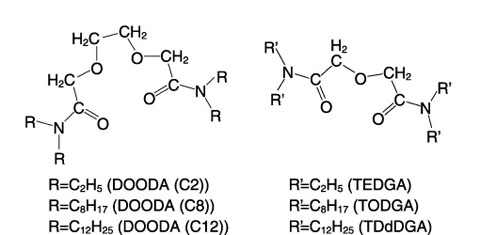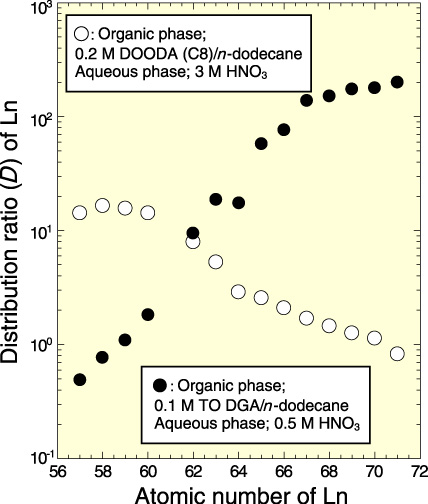
Fig.7-14 Structures of dioxaoctanediamide (DOODA) and diglycolamide (DGA) compounds

Fig.7-15 Relationship between distribution ratio (D) for tetraoctyldiglycolamide (TODGA) and tetraoctyl-dioxaoctanediamide (DOODA (C8)) and atomic number of lanthanides (Ln’s)
Table 7-1 Separation factor (SF) of Am/Cm

Am and Cm in highly radioactive liquid waste have a long half-life and cause high heat generation. There is a concept to separate and dispose of these elements by a suitable technique (e.g., transmutation and geological disposal) in order to reduce radioactive waste. Therefore, the mutual separation of Am and Cm is an important research subject. However, the chemical properties of Am are very similar to those of Cm, and the separation methods reported so far have not shown fully the useful results for the practical application.
We have developed novel and promising extractants, like diglycolamide (DGA) and dioxaoctanediamide (DOODA); these diamides can be converted to water-soluble compounds (Fig.7-14). Noting that a solvent extraction system is composed of aqueous and organic phases, we have considered that the separation factor (SF) between Am and Cm may be increased by the synergistic effect when hydrophilic or lipophilic diamide is dissolved in each phase. Fourteen lanthanide (Ln) ions are examined in place of Am and Cm in this work.
From the solvent extraction study involving the use of tetraoctyldiglycolamide (TODGA) and tetraoctyl-dioxaoctanediamide (DOODA (C8)), it has been found that the distribution ratio (D) increases or decreases with the atomic number of Ln’s (Fig.7-15). This result indicates that lighter and heavier Ln’s are more extractable by DOODA (C8) and TODGA, respectively. In the Ln element series, the chemical behavior of Nd(III) and Sm(III) is close to that of Am(III) and Cm(III). In order to examine the synergistic effect on mutual separation, two diamide compounds are used simultaneously in the aqueous and organic phases. Here, the two available diamides may show the opposite trends when used for Ln extraction, as shown in Fig.7-15.
Higher SFs between Am and Cm have been obtained by using two diamides compared to the SF when only one extractant is used, as seen in Table 7-1. Here, the SFs are obtained from the ratio D(M)/D(M’), and a high SF implies high separation performance. As shown in Table 7-1, the synergistic effect on the mutual separation between Am and Cm can be seen in this extraction system. If we have a higher SF, a better extraction process can be used. From the results of a simple calculation for multistep extraction, it has been confirmed that an SF value of 3.6 for Am/Cm gives sufficient separation performance. Our efforts toward the development of new extractants and masking agents has been continuing. In the future, we intend working toward achieving high SF values by using effective combinations of diamides, and designing a simple and practical partitioning process.